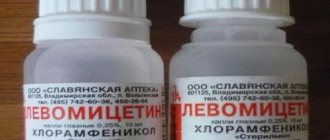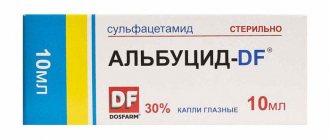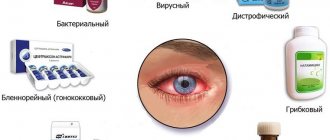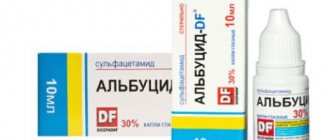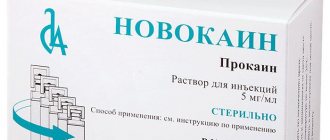About the drug
An effective antimicrobial, anti-infective and bacteriostatic agent . Active against gram-positive and gram-negative microorganisms, such as:
- streptococci;
- staphylococci;
- chlamydia;
- gonococci;
- toxoplasma (including Staphylococcus aureus, which is known for its resistance to many antibacterial drugs).
It is able to eliminate nasal congestion and fight purulent eye infections in a short time. If necessary, it can be prescribed for otitis media. The most important drug that should be in every first aid kit.
Release form
The drug Albucid (also called Sulfacyl sodium or sodium sulfacetamide) is produced in the form of ointment, injection solution and drops. The solution is used for inflammatory diseases of the lungs and urinary tract.
In ophthalmology it is used in the form of drops and ointments . The drops are contained in a bottle - a dropper, with a volume of 0.5 to 10 ml and have a transparent consistency.
Compound
The drug Albucid contains:
- sulfacetamide;
- hydrochloric acid;
- sodium thiosulfate;
- distilled water.
Sulfacyl sodium is the main active ingredient. Thiosulfuric acid, sodium salt and purified, specially prepared water for injection act as excipients. For adult patients, a 30% concentration of sulfacetamide solution is presented; for children, 20 mg per 1 ml of solution is used.
Indications for use
Albucid is intended for external use only. Due to the fact that the drug has proven itself to be a safe and most effective remedy, drops can be prescribed during pregnancy for the following diseases:
- persistent rhinitis;
- barley;
- inflammation of the ocular conjunctiva with signs of purulent lesions (blennorrhea);
- otitis;
- bacterial conjunctivitis;
- injury or injury to the cornea of the eye;
- blepharitis (inflammation of the eyelid of varying severity);
- keratitis.
Sulfacyl sodium eye drops - instructions for use
Ophthalmic drops Sulfacyl sodium is a broad-spectrum medicine that is recommended for the treatment of eye inflammation. It affects common groups of bacteria and pathogens, penetrates deeply into tissues, eliminating relapse of the disease. The simple composition allows the drug to be used in the treatment of preschool children and has a low risk of allergies.
Composition and release form
Sulfacyl sodium - sulfonamide-based eye drops. The domestic drug is recommended for the treatment and prevention of ophthalmic diseases and is used in pediatrics. It is distinguished by its simple composition:
- sodium thiosulfate;
- hydrochloric acid;
- distilled water;
- sodium sulfacetamide.
The latter component is sometimes included in the formula of antibacterial drugs, so patients mistakenly consider it an antibiotic. The drug is a liquid and sterile solution for topical use, odorless or colorless. Depending on the manufacturer, you can find different release forms in the pharmacy: transparent bottles with a pipette dispenser with a volume of 1 to 10 ml.
For treatment, the doctor must select an eye solution of the required concentration:
- for infants the drug is used 10%;
- for adults and teenagers – 20 and 30%.
pharmachologic effect
Sulfacyl sodium eye drops have an antimicrobial effect. During treatment, active substances penetrate cell membranes, destroying the pathogenic microorganism from the inside, disrupting the process of division and reproduction at any stage of the cycle. The drug is recommended for identifying most known pathogens:
- gonococci;
- Staphylococcus aureus;
- streptococcus;
- chlamydia;
- coli and Pseudomonas aeruginosa.
Drops of Sulfacyl Sodium Dia quickly neutralize the simplest and dangerous microbes and are used for washing away contaminants. The beneficial effect is observed after the first use.
Indications
Sulfacyl eye drops are a time-tested remedy recommended by ophthalmologists for the treatment of newborns and infants. It becomes a regular medicine in the first aid kit of people who work with dust, welding or pollution. Main indications for use:
- suppuration of the cornea due to barley;
- open sores on the inside of the eyelid;
- blepharitis;
- blenorrhea in children;
- ocular gonorrhea in an adult;
- conjunctivitis of any type;
- complication of seasonal allergies.
Eye medicine Sulfacyl sodium is prescribed after ophthalmic surgery to exclude inflammation and secondary infections. Reduces the risk of bacterial damage to the cornea.
Mode of application
Sulfacyl sodium eye drops 20% concentration are recommended for the treatment of conjunctivitis with copious discharge of purulent contents. In case of exacerbation, they should be used as follows:
- Wash your hands with antibacterial soap and, if necessary, wipe with an antiseptic.
- Thoroughly clean the eyelashes and the interlash line using a cotton swab and a solution based on Furacilin.
- Open the medicine with clean hands.
- Pull the lower eyelid down and carefully drip the drug into the conjunctival sac.
During the procedure, it is necessary to ensure that the dispenser does not touch the inflamed area: otherwise, there is a risk of re-infection, and the treatment becomes ineffective.
If the patient is a child, the instructions for use contain the following recommendations:
- for newborns, drops of 10% concentration 2-3 times a day are recommended;
- for children over 6–7 years old, you can take a 20% solution, 2 drops up to 3 times a day;
- a school-age child and an adult patient use the medicine 3 times a day, 2-3 drops.
To prevent blenorrhea in newborns, the medicine is dripped every 2 hours after birth, 1-2 drops into each eye. In case of exacerbation with severe suppuration in adults, the dosage is increased to 5-6 treatments per day with a 30% solution.
If inflammation or styes occur frequently, doctors recommend periodically adding a few drops to the lens solution. This helps the patient cope with the consequences of seasonal allergies and reduces irritation after surgery on the cornea or lens.
Side effects
In rare cases, eye drops provoke temporary complications, accompanied by itching and burning. This is due to the appearance of erosions or an allergic reaction. In the absence of swelling and other unpleasant symptoms, treatment with Sulfacil can be continued.
Some patients experience a white coating during therapy after using sulfacylamide-based drops. This is not a side effect, but residues of the active substance on the skin of the eyelid. It can be washed off with saline solution, clean water or Furacilin diluted in water.
Overdose
Before using the solution, you must carefully read the instructions. If the dosage is violated, a temporary deterioration in the condition, a sensation of a foreign body or “sand” in the eyes, redness, itching or swelling of the eyelid may occur. In such a situation, it is better to stop using the drops before visiting an ophthalmologist.
Read more Instructions for using Inocaine eye drops
Additional Information
The main indication for treatment with Sulfacyl sodium drops is conjunctivitis of a viral or bacterial nature. It is necessary to instill drops in each eye, even if there is no inflammation in one. During the procedure, the dispenser should not touch the affected area: otherwise, there is a risk of infection of the healthy cornea, and the course of therapy will be delayed.
Interaction with other drugs
Drops have a depressing effect on some medications, so before treatment you should discuss the dosage and possible replacement with your doctor. It is prohibited to instill simultaneously with any alkaloids and silver-based products: the components enter into a chemical reaction, provoking severe allergies.
The antibacterial effect is significantly reduced when used simultaneously with the following medications:
- Novocaine;
- Dicaine;
- Anestezin;
- direct acting anticoagulants.
When used with Diphenin or salicylic acid, the drug may exhibit toxicity and side effects. Drops should be used with extreme caution in patients who constantly use Furosemide or thiazide diuretics: eye hypersensitivity is often observed when sodium balance is disturbed.
Vacation conditions and shelf life
To purchase the drug, you do not need a doctor's prescription: the prescribed composition can be found in any pharmacy. When sealed, the bottle with dispenser can be stored for up to 2 years from the production date at room temperature 20–25°C. Sulfacyl drops should be left in a place protected from direct sunlight to avoid heating or oxidation of the composition.
The shelf life of the medicine after opening is no more than 4 weeks. This short-term storage is due to the peculiarities of the chemical formula: with prolonged contact with oxygen after opening the bottle, sulfacyl oxidizes and loses its medicinal properties. Therefore, for the treatment of mild forms of conjunctivitis, it is better to purchase a small package of 5 ml.
The price of the drug depends on the manufacturer and the volume of the bottle. Children's drops with a concentration of 10% cost from 19 rubles. The cost of Sulfacyl sodium 20% starts from 23 rubles.
Special instructions and precautions
The drug does not affect the patient’s ability to drive vehicles and machinery. Mild impairment of visual acuity disappears within 10–15 minutes, so it can be used for work that requires precision and coordination.
Sulfacyl sodium 10% is often used to prevent eye infections in newborns: when passing through the birth canal, infection with pathogenic microflora occurs, increasing the risk of blenorrhea.
It is used once after delivery, treating each eye. In rare cases, with bacterial rhinitis, you can drop drops into the baby’s nose, replacing more allergenic antibiotics with a simple and safe remedy.
Read more Hofitol drops for children and adults - instructions and analogues
Sulfacyl sodium has repeatedly participated in clinical trials.
It is not absorbed into the bloodstream, so many experts approve of its use in the treatment of women at any stage of pregnancy, during breastfeeding.
The only recommendation is strict adherence to dosage and precautions when treating inflamed eyes.
Reviews
In 90% of cases, reviews of the drops are positive, but sometimes concerns arise - is it an antibiotic or not. Considering the safe and clinically proven composition, the doctor prescribes the product to newborn patients without fear of disturbing the balance of microflora.
My little daughter brought conjunctivitis from kindergarten. In the morning I woke up with reddened eyes, and in the evening a yellow coating appeared, which hardened into crusts. The doctor recommended Sulfacyl sodium drops 4 times a day. Despite the low price, they turned out to be very effective: by the next evening the swelling and redness subsided, and the amount of discharge decreased. Therefore, I can only recommend the drug to other parents. I have been using Sulfacyl sodium drops for many years: this is a real standby remedy in the home medicine cabinet. I use it after work in the country, if dirt gets into my eyes, they helped me in the treatment of stye on the lower eyelid. Sometimes after instillation there is a slight burning sensation that goes away after 5–10 seconds. I consider this an insignificant drawback compared to the low price and great benefits. 2 weeks after birth, my son had an obstruction of the lacrimal canal, his left eye was constantly festering and swelling. The doctor recommended instilling Sulfacyl sodium drops 4-5 times during the day, and did a special massage to remove pus. Within a week, the problem completely disappeared without complications, although there was a question about probing.
Source: //infofarma.ru/kapli/sulfatsil-natriya
Is it possible for pregnant women to drip the drug into the nose and eyes?
Pregnant mothers can safely use the drug Albucid and not be afraid for their well-being and the health of the baby , since drops are used to treat the eyes of even newborn children to avoid possible infection during childbirth. The only condition when the drug is contraindicated for pregnant and nursing mothers is if there is an individual intolerance to one of the components of Albucid.
In 1st trimester
All organs of the unborn child and the placenta are formed; the use of any drugs during this period is undesirable. Prescribing sodium sulfacyl is permissible as a last resort and only by the attending physician.
In the 2nd trimester
The placenta and organs of the child are already formed, the baby is growing and gaining weight, its first tremors are felt, and therefore young mothers should not be afraid to take Albucid if necessary.
In the later stages
In the 3rd trimester, the baby moves more actively, and the final formation of its organs and systems occurs. This is the most responsible during pregnancy. A woman's body is preparing for childbirth. If there is a need to take the drug, then there are no restrictions.
Due to the fact that the fetus is already formed, the active ingredients will not harm the unborn child. Exceptions are those cases when there are disturbances in the functioning of the liver and excretory system in pregnant women. Considering that the drops are used topically, there is no need to be afraid of their possible negative impact on the child’s health during pregnancy or lactation.
The effect of the drug is safe in that it does not enter the bloodstream, and therefore eliminates the possibility of harm to the baby.
Albucid during pregnancy: application features – Website about eye diseases
27.12.2019
A decrease in the female body’s immune defense during gestation makes it more susceptible to the negative effects of pathogenic microorganisms. A weakened body is not always able to maintain health by promptly suppressing the attacks of viruses and bacteria. The result is the development of infectious diseases.
The most common portals of infection are the nasal cavity and eyes. Once on the mucous membrane, microbes begin to actively multiply, causing rhinitis and inflammation of the conjunctiva. An effective remedy often used to treat many eye diseases is Albucid. Are these drops safe while expecting a baby? Is it possible to take Albucid during pregnancy?
Albucid during pregnancy, 2 ways to use drops
If treated in a timely manner, conjunctivitis cannot be considered a dangerous disease during pregnancy. However, the unpleasant symptoms of inflammation of the conjunctiva can cause a woman in the position a lot of discomfort.
One of the most common drugs used to treat ophthalmic diseases is Albucid. Of course, expectant mothers are primarily concerned about the safety of the medicine for the baby in the tummy.
Let's find out whether Albucid can be used during pregnancy, how to do it correctly and what can replace this drug.
About the drug albucid
- A 30% solution of sulfacetamide is used in the treatment of adult patients;
- The 20% solution is intended for children.
Once on the mucous membrane of the eye, the drops quickly penetrate deep into the tissues and are absorbed into the bloodstream.
The drug has a low cost, around 60 rubles per bottle, therefore, despite the abundance of alternatives, it is widely used to treat eye diseases and more.
You will not find the following information in the instructions, but Albucid is often used to treat a runny nose, but more on that a little later.
Admission rules
During pregnancy, taking the drug depends on the type and degree of the disease. Start treatment with 2-3 drops up to 6 times a day and continue taking it for a week, but no more. If there is an improvement in the patient's condition, the frequency of taking the drug is reduced.
After applying the drops, it is recommended to take a horizontal position for a few minutes and lightly massage the closed eyelids. If after seven days of continuous use of the drug there is no improvement, then you should consult a doctor to prescribe another treatment.
Most often, this drug is prescribed for eye diseases, but this does not prevent it from being successfully used in the treatment of runny nose during pregnancy.
Contraindications
Albucid is contraindicated if there is an individual intolerance or an allergic reaction to one of the components of the drug. In the third trimester of pregnancy, if there are disturbances in the functioning of the liver, increased sensitivity to the active substance, as well as disturbances in the functioning of the excretory system, the drops are taken only after consulting a doctor.
It is not recommended to take Albucid with other drugs similar in action, in order to avoid a decrease in the therapeutic effect. It is contraindicated to simultaneously use drugs that contain silver salts.
The opinion of official medicine
Official medicine does not agree with Komarovsky’s methods of treating rhinitis.
Most doctors rely on the fact that not a single medical reference book or textbook contains any reference to the use of this drug as a remedy for the common cold. Therefore, the doctor has no right to prescribe a remedy whose effect has not been confirmed anywhere. Even if rhinitis is caused by bacteria, they gradually get used to this medicine, and its subsequent use against other diseases (for example, eye treatment) will not have any effect.
Another important point is to obtain an analysis of the child’s nasal discharge. The doctor must make sure that the infection is truly bacterial. Bacteriological research is carried out over 4 days. During this time, the runny nose may already go away.
The baby’s parents should talk to the doctor, find out the cause of the disease and decide who to trust: official medicine or Dr. Komarovsky. After all, every parent takes responsibility for the health of their child.
Adverse reactions
The occurrence of side effects is extremely rare, and they are usually associated with overdose and frequent use of the drug. These include:
- swelling and redness of the eyelids;
- pain;
- severe itching and burning in the eyes.
While taking the drug, a slight burning sensation and slight itching are acceptable , which disappear after 1 - 2 minutes and do not require discontinuation of the drug. However, if the burning and itching intensify, it is necessary to rinse the eyes with warm, boiled water.
In the event that pregnant women are unable to tolerate a slight burning sensation and discomfort while taking the drug, mixing the medication with physiological solution (saline) is allowed, subject to the proportions being clarified by the doctor.
Eye drops
This is not the only name of the drug, since in medicine there is another designation for eye drops - Albucid. This is a pharmaceutical solution whose active ingredient is sulfacetamide. The drug is absolutely safe for the eyes due to its water base with a low alkalinity reaction. Eye drops also have an international name - Sulfacetamidum.
Sulfacyl
Due to its pronounced antimicrobial properties, the drug is actively used in ophthalmic practice. The main difference between this antiseptic and antibiotics is the nature of its origin, so Albucid can also be prescribed to children.
Albucid
special instructions
Before using this product, the cap on the bottle should not be screwed on tightly. As for the first use, before such a procedure the cap must be screwed all the way. In this case, the spike, which is located on its inner side, should pierce a hole in the membrane.
Before direct use, it is recommended to hold the bottle of medicinal liquid in your hand so that it warms up to the temperature of the human body. After this, the cap must be unscrewed, removed, and then lightly pressed on the soft body and dripped the solution into the eyes.
At the end of the treatment procedure, the bottle of medicine should be tightly closed.
Difference in drugs
Pharmacy chains may sell this drug under different names. In this regard, many consumers have a logical question about what is the difference between Sulfacyl Sodium medications and Sulfacyl Sodium-DIA. Experts answer it unequivocally.
These drugs are no different from each other (neither in principle of action nor in composition). Both medications can be used for conjunctivitis, eye trauma, blenorrhea and other abnormalities. The only difference between them is that they have different manufacturers.
In particular, the drug “Sodium Sulfacyl-DIA” is manufactured, which explains its name.
Drug interactions
| Category ICD-10 | Synonyms of diseases according to ICD-10 |
| A54. 3 Gonococcal eye infection | Blennorea |
| Blennorea in newborns | |
| Gonoblenorrhea | |
| Gonococcal conjunctivitis in adults | |
| Gonorrheal eye diseases | |
| Acute gonococcal conjunctivitis | |
| A74. 0 Chlamydial conjunctivitis | Ocular chlamydial infection |
| Infectious conjunctivitis and keratoconjunctivitis caused by Chlamydia trachomatis | |
| Chlamydial eye infection | |
| Chlamydial eye diseases | |
| Chlamydial blepharoconjunctivitis | |
| Chlamydia of the organs of vision | |
| H01.0 Blepharitis | Blepharitis |
| Inflammation of the eyelids | |
| Inflammatory diseases of the eyelids | |
| Demodectic blepharitis | |
| Superficial bacterial eye infection | |
| Superficial eye infection | |
| Squamous blepharitis | |
| H10 Conjunctivitis | Bacterial conjunctivitis |
| Infectious-inflammatory conjunctivitis | |
| Superficial eye infection | |
| Red eye syndrome | |
| Chronic non-infectious conjunctivitis | |
| H16.0 Corneal ulcer | Allergic marginal corneal ulcer |
| Allergic corneal ulcer | |
| Bacterial corneal ulcer | |
| Purulent corneal ulcer | |
| Purulent corneal ulcers | |
| Corneal ulceration | |
| Ulcerations of the superficial layers of the cornea | |
| Keratitis with corneal ulcerations | |
| Keratomalacia | |
| Corneal ulcer | |
| Corneal marginal ulcer | |
| Recurrent corneal erosions | |
| Recurrent corneal ulcers | |
| Septic corneal ulcer | |
| Traumatic corneal erosion | |
| Trophic ulcers of the cornea | |
| Epithelial punctate keratitis | |
| Corneal erosion | |
| Regional ulcer | |
| Corneal ulcer | |
| Ulcerative keratitis | |
| P39.8 Other specified infection specific to the perinatal period | Blennorea in newborns |
| Nosocomial infections in newborns | |
| Neonatal herpes |
Sulfacyl Sodium Drops
Ophthalmology today uses a wide range of drugs that can effectively cope with infections that affect the human eye.
Doctors often prescribe Sulfacyl sodium drops (Sulfacyl soluble), which are used to treat infectious eye diseases caused by pathogenic microorganisms.
Some patients are interested in the difference between Albucid and Sulfacyl sodium: this is one medicine, the first name is considered outdated. It is necessary to strictly adhere to the instructions for use of the ophthalmic drug.
Release form
Anti-infective eye drops are produced in polyethylene bottles of 5 and 10 ml. They are hermetically sealed with special dropper caps and lids. All bottles are placed in separate cardboard boxes, each containing instructions for using sulfacetamide. You can also find medicine sets of 50 bottles per box.
Pharmacodynamics and pharmacokinetics
The drug belongs to the broad-spectrum sulfonamide antimicrobial agents. This medication also has a bacteriostatic effect.
Drops are no worse than antibiotics in helping to fight gram-negative and gram-positive bacteria (gonococci, streptococci, E. coli), actinomycetes, and chlamydia. When the medicine is used topically, the active substance enters the fluids and tissues of the eyes.
Sulfacetamide can also penetrate through the conjunctiva affected by a bacterial infection into the systemic circulation.
Which is better Sulfacyl sodium or Albucid
Patients often think about this, especially young mothers, who are faced with the choice of using Albucid or Sulfacil to treat their newborn children. Experts believe that both of these drugs are beneficial and help quickly get rid of infection and inflammation.
Both drugs are available in the form of a solution intended for eye drops. They negatively affect pathogenic organisms, preventing them from multiplying and spreading throughout the body.
Source: //hospitalvv.ru/glaza/sulfat-natriya-kapli-glaznye.html

